 W
WGeorgian cuisine is a traditional cuisine of Georgia. Georgian cuisine has similarities with Caucasus cuisine. Every region of Georgia has its own distinct style of food preparation. Eating and drinking are important parts of Georgian culture.
 W
WAjapsandali is a traditional Georgian and Armenian dish, also popular in the Northern Caucasus. It consists of onion, eggplant, tomato and bell pepper grilled, stewed, or fried in vegetable oil and seasoned with garlic, basil, coriander leaves, parsley and other seasoning. Sometimes potato, chili pepper and even carrots are added although traditional recipes don't include them.
 W
WAjika or adjika is a Georgian-Abkhazian hot, spicy, but subtly flavored dip, often used to flavor food. In 2018, the technology of ajika was inscribed on the Intangible Cultural Heritage of Georgia list.
 W
WNigvziani Badrijani is a Georgian dish made with fried eggplant stuffed with spiced walnut and garlic paste. It is often topped with pomegranate seeds.
 W
WChacha is a Georgian pomace brandy, a clear and strong, which is sometimes called "Wine vodka", "grape vodka", or "Georgian vodka/grappa". It is made of grape pomace. The term chacha is used in Georgia to refer to grape distillate. It may be also produced from unripe or wild grapes. Other common fruits or herbs used are figs, tangerines, oranges, mulberries or tarragon.
 W
WChakapuli is a Georgian stew. It is considered to be one of the most popular dishes in Georgia.
 W
WChakhokhbili is a traditional Georgian dish of stewed chicken, tomato with fresh herbs.
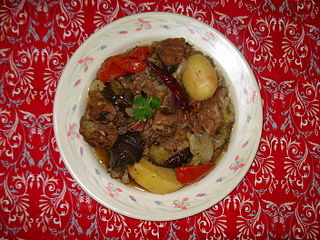 W
WChanakhi is a traditional Georgian dish of lamb stew with tomatoes, aubergines, potatoes, greens and garlic.
 W
WThis is a list of Georgian cheeses. Over 250 varieties of cheese are produced in Georgia.
 W
WChicken tabaka or chicken tapaka is a traditional Georgian dish of a pan-fried chicken which is also popular in other Caucasian cuisines. It also became a common restaurant dish in the Soviet cuisine and is found nowadays in many restaurants throughout Eastern Europe and Central Asia.
 W
WShkmeruli is a traditional Georgian dish of chicken in garlic sauce.
 W
WChurchkhela is a traditional Georgian cuisine candle-shaped candy. The main ingredients are grape must, nuts, and flour. Almonds, walnuts, hazelnuts, and chocolate and sometimes raisins are threaded onto a string, dipped in thickened grape juice or fruit juices and dried in the shape of a sausage. The traditional technology of churchkhela in the Kakheti region was inscribed on the Intangible Cultural Heritage of Georgia list in 2015.
 W
WDolma is a family of stuffed dishes from Ottoman cuisine that can be served warm or cold. Some types of dolma are made with whole vegetables, fruit, offal or seafood, while others are made by wrapping leaves, most commonly grape or cabbage leaves, around the filling. Wrapped dolma, specifically, are also known as sarma.
 W
WMany cuisines feature eggplant salads and appetizers.
 W
WGeorgian bread is bread from the country of Georgia. პური (puri) means bread in Georgian. Varieties of Georgian bread includeTonis puri Shotis puri Khachapuri
 W
WGozinaki or Gozinaqi is a traditional Georgian confection made of caramelized nuts, usually walnuts, fried in honey, and served exclusively on New Year's Eve and Christmas. In the western Georgian provinces of Imereti and Racha, it was sometimes called Churchkhela, a name more commonly applied to walnuts sewn onto a string, dipped in thickened white grape juice and dried. In several of Georgia's rural areas, both walnuts and honey used to have sacral associations. According to a long-established tradition, Gozinaki is served at special occasions, and is a mandatory component of New Year's Eve/Christmas celebrations.
 W
WKhachapuri is a traditional Georgian dish of cheese-filled bread. The bread is leavened and allowed to rise, molded into various shapes, and then filled in the center with a mixture of cheese, eggs, and other ingredients. The bread crust is traditionally torn off and dipped into the cheese.
 W
WKhash is a dish of boiled cow or sheep parts, which might include the head, feet, and stomach (tripe).
 W
WKhinkali is a very popular dumpling in Georgian cuisine. It is made of twisted knobs of dough, stuffed with meat and spices.
 W
WKhmeli suneli is a traditional Georgian spice mix. It typically contains ground coriander seed, celery seed, dried basil, dill, parsley, blue fenugreek, summer savory, bay leaf, mint and marigold.
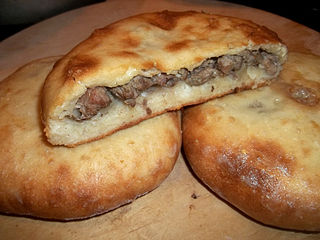 W
WKubdari or Kubed is a Georgian filled bread dish which is particularly a national dish of the Svans. The bread is leavened and allowed to rise. The filling contains chunks of meat, which can be lamb, kid or pork, Georgian spices and onions. Kubdari was inscribed on the Intangible Cultural Heritage of Georgia list in 2015.
 W
WKuchmachi is a traditional Georgian dish of chicken livers, hearts and gizzards with walnuts and pomegranate seeds for topping.
 W
WKupati is a type of Georgian sausage that is made from ground pork, intestines or chitterlings, pepper, onions. It is popular in the Caucasus region.
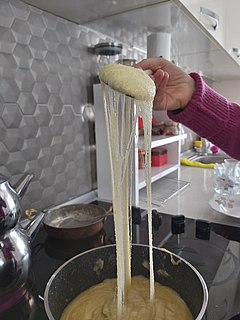 W
WKuymak or Kachi is an Iranian dessert. Its primary ingredients are corn meal and cheese. It is also popular in Georgia, Azerbaijan and some regions of Caucasus.
 W
WLaghidze water is a popular Georgian soft drink based on soda and a variety of natural syrups. It has been traditionally mixed in a glass from a soda fountain, but it is also available as a bottled soft drink in a range of flavors. Some American food writers liken it to egg cream, but the authentic Georgian drink includes neither milk nor chocolate syrup.
 W
WLobiani is a traditional Georgian dish of bean-filled bread. In Georgia the most popular is Rachuli Lobiani, like a Khachapuri, but with beans.
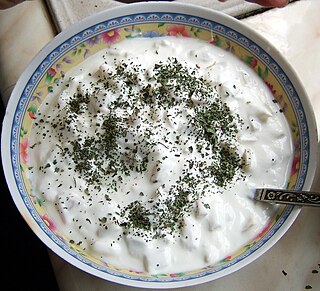 W
WMatzoon or matsoni is a fermented milk product of Armenian origin, distributed in Armenia and Georgia. In Japan, it is called Caspian Sea yogurt.
 W
WMchadi is a traditional Georgian cornbread traditionally eaten with lobio and cheese.
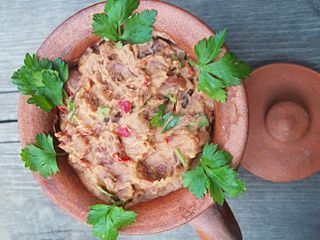 W
WLobio is a traditional Georgian dish of various kinds of prepared beans, containing coriander, walnuts, garlic and onion. There are many varieties of lobio, both hot and cold.
 W
WPelamushi is a Georgian dessert porridge made in autumn at the vintage time with flour and pressed, condensed grape juice.
 W
WPkhali is a traditional Georgian dish of chopped and minced vegetables, made of cabbage, eggplant, spinach, beans, beets and combined with ground walnuts, vinegar, onions, garlic, and herbs. Pkhali is also called mkhali. The common ingredient of all variations of pkhali is pureed walnut sauce. In Georgian restaurants, pkhali is usually served in three types: spinach, beetroot and white beans.
 W
WSarma, commonly marketed as stuffed grape leaves, is a type of dolma—a stuffed dish of the cuisines of the former Ottoman Empire from the Middle East to Southeastern Europe—comprising grapevine, cabbage, monk's rhubarb, kale or chard leaves rolled around a filling of grains, minced meat, or both.
 W
WSatsebeli is a Georgian sauce made of tomato paste, cilantro, garlic, vinegar, pepper, khmeli suneli, water and adjika chili paste. It is very hot.
 W
WSatsivi is a Georgian dish made from poultry such as turkey or chicken put into walnut sauce. The term satsivi is also used as a generic name for a variety of poultry made with the walnut sauce.
 W
WShashlik, or shashlyk, is a dish of skewered and grilled cubes of meat, similar to or synonymous with shish kebab. It is known traditionally by various other names in the Caucasus and Central Asia, and from the 19th century became popular as shashlik across much of the Russian Empire and nowadays in the Russian Federation and former Soviet republics.
 W
WShotis puri or simply shoti is a type of traditional Georgian bread, made of white flour and shaped like a canoe. Shoti is baked in a specific bakery called tone or torne/turne. The word is cognate with tandoor. The bread is served as any other bread, but it tends to be more popular on special celebrations such as Easter, Christmas, and New Year's Day, as well as birthdays and weddings. It gets its distinctive shape from the method of cooking, as long strands of dough are stuck to the inside of a traditional round well-shaped brick or clay oven.
 W
WStaphylea colchica, the Caucasian bladdernut, Colchis bladdernut, or Georgian: ჯონჯოლი, jonjoli or djondjoli, is an ornamental shrub in the Staphyleaceae family. It is native to western Georgia. Its binomial name is derived from the western Georgian kingdom of Colchis.
 W
WSujuk or sucuk is a dry, spicy and fermented sausage which is consumed in several Balkan, Middle Eastern and Central Asian cuisines. Sujuk mainly consists of ground meat and animal fat usually obtained from beef or lamb, but horse meat is also often used in Bulgaria, Kazakhstan and Kyrgyzstan.
 W
WSulguni is a brined Georgian cheese from the Svaneti and Samegrelo regions. It has a sour, moderately salty flavor, a dimpled texture, and an elastic consistency; these attributes are the result of the process used, as is the source of its nickname "pickle cheese". Its color ranges from white to pale yellow. Sulguni is often deep-fried, which masks its odor. It is often served in wedges.
 W
WA tamada is a Georgian toastmaster at a Georgian supra (feast) or at a wedding, corresponding to the symposiarch at the Greek symposion or the thyle at the Anglo-Saxon sumbel.
 W
WA tandoor also known as tannour is predominantly a cylindrical clay or metal oven used in cooking and baking. The tandoor is used for cooking in Southern, Central, and Western Asia, as well as in the South Caucasus.
 W
WTkemali is a Georgian sauce primarily made of cherry plum, sometimes alucha or other varieties of plum. Both red and green varieties of plum are used. The flavor of the sauce varies, but generally tends to be pungently tart. To lower the tartness level, occasionally sweeter types of plums are added during preparation. Traditionally, besides plum the following ingredients are used: garlic, pennyroyal, cumin, coriander, dill, chili pepper and salt.
 W
WTonis puri is a type of Georgian bread, baked in a specific oven called a tone or torne. The word is cognate with tandoor. The bread is served as any other bread, but it tends to be more popular on special celebrations such as Easter, Christmas, and New Year's Day, as well as birthdays and weddings.
 W
WTrigonella caerulea is an annual herb in the family Fabaceae. It is 30–60 cm tall. Its leaves are obovate or lance-shaped, 2–5 cm long, 1–2 cm wide and saw-toothed in upper part. Its flower stalks are compact, globular racemes, longer than the leaves. The sepals are twice as short as the corolla, its teeth are equal to the tube. The corolla is 5.5-6.5 mm long and blue. The pods are erect or slightly curved, compressed, 4–5 mm long with beak 2 mm. The seeds are small and elongated. It blossoms in April–May, the seeds ripen in May–June. It is self-pollinated.